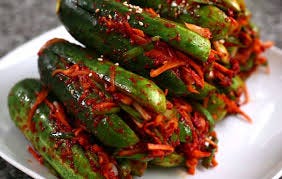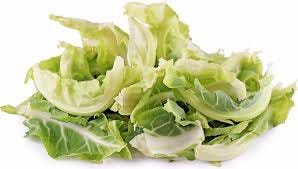Many months ago, I wrote the first of a series of articles all about Kimchi, and I’m not sure why it’s taken this long to do part 2 but here it is! If you’d like a refresher of the first bit (about its cultural importance and our new-found enthusiasm for it) please do follow This link…
I’ve been thinking about how, with so little personal experience of Kimchi’s deeply entrenched history and traditions, we (non-Koreans) can create something authentic enough to bear its name; there are all kinds of obstacles in our way from the obvious cultural limitations, to more tangible issues relating to vegetables and temperatures and jars etc… so I’m starting to unravel them here.
Cultural considerations.
There are a several deeply pleasing concepts behind food production and consumption in Korea. In addition to their autumn kimchi-making tradition of Kimjang, which survives even in our age of convenience, there is the concept of Son Mat. This can be roughly translated as (mother’s) “hand taste” – the idea that when food is made by hand, the effort and sentiments behind it can actually be tasted in the food – for me that’s a primary reason to go to the trouble of making your own. It also encompasses the idea of handing down traditions, and then there’s also the effect of the microbiota of the hands involved being involved in the development of flavour especially in fermented foods!
We established in Part 1 that South Korea is happy for the world to embrace and incorporate their signature dish into their own national cuisines as they see fit. But that doesn’t mean we should play fast and loose with it; UK-based Korean kimchi expert Rebecca Ghim told me that for her, and she imagined many of her compatriots, it’s important to have an understanding of the cultural importance and history of their national dish before embarking on your kimchi-making journey;
The kimchi culture of Korea developed from the urge to store and preserve food, particularly during the long harsh winters when many people died of starvation. Unlike in China where pickling and frying were the prevalent methods for food preservation, limited availability of cooking oils in Korea led to the use of fermentation instead (1). As trade routes developed bringing new crops and flavours, the complexity of kimchi increased, with recipes incorporating spices, colourful vegetables, fish, nuts and seaweed.
As a healthy food, kimchi represents the basic Korean philosophy of yak sik dong won, implying that food and medicine come from the same source or, in other words, food is medicine. There is also a common saying “if you have kimchi and rice, you have a meal” – i.e. its all the nutrition you need.
Kimchang, Korea’s winter kimchi-making festival, is of such importance that it’s registered on the UNESCO’s list of Intangible Cultural Heritage of Humanity.
Between 1910 and 1945, Korea was annexed by the Empire of Japan after years of war, intimidation and political machinations. To establish control over its new protectorate, the Japanese Empire waged war on Korean culture. Korean citizens used kimjang as a silent protest to all that was going on around them and successfully managed to maintain its importance throughout that time (2)
What IS Real kimchi?
The term Kimchi is said to be derived from “Chimchae”, which means “soaking vegetables”, and as we saw in part one, even though there’s an official definition to provide it some cultural protection, there are at least 200 documented recipes, not including local and familial variations.
Some recipes are quick, some are slow, they may be white, or red with the addition of gochugaru chilli powder; some use what we see as typical ingredients like Napa cabbage and daikon radish, others use cucumber, mustard greens, perilla leaves, or spring onions as the main ingredient. There may be few components, or many; some are entirely vegetable based, others contain types of fish, either fresh, occasionally still breathing, or fermented, and sometimes meat. Brine-based or thickly coated in sauce, whole chopped, long-fermented over the winter or ready in a few days, fermented or eaten fresh just as soon as its made, it’s a long list!




With such great variation you could be forgiven for wondering if there is there anything unique about kimchi at all! If you can use any ingredient then isn’t sauerkraut also a type of kimchi? Well technically, but self-brining dry ferments aren’t typical in Korea – you can use white cabbage as a kimchi ingredient though it’s a very recent addition to Korean cuisine – it’s called yangbaechu kimchi. I’ve made what I call kimchi kraut which is wrapping red or white cabbage in leftover kimchi paste and it is different and delicious!
§For additional reassurance, there is also scientific evidence that points to kimchi’s uniqueness, which we can see when we compare it with sauerkraut. While there’s definitely overlap in the microbial profile of the two ferments, kimchi is host to more Weissella species (a type of lactic acid bacterium) which produce a different range of end products and flavours at fridge temperatures and below 15 oC and is often “fizzy” due to the production of carbon dioxide during the whole fermentation process, as opposed to mainly in the initial stages of sauerkraut. The pH of kimchi is optimal between 4.2 and 4.5, whereas the pH of finished sauerkraut is usually around 3.7. The optimum acidity of kimchi is 0.4-0.8% lactic acid while that of sauerkraut can be more than 2%.
Practical considerations – how to apply these principles.
It can be helpful to think about Kimchi not just as a “product” but also as “process” or even a philosophy, encompassing the ideas of food preservation, nutrition, nurturing, tradition and self-sufficiency mentioned above.
So the question to ask is “am I kimchi-ing to the best of my ability?”
Making it by hand and the effort involved certainly will satisfy the “son mat” angle and I’m sure all your friends and family will taste the difference…
Kimchi-ing (new gerund!) as a waste-saving exercise would also certainly fit the bill. You can follow the example of Rebecca Ghim who collects unwanted local cauliflower leaves (from high end places like Ottolenghi’s restaurants no less!) and turns them into delicious kimchi, or make a mixed kimchi with odds and ends of whatever is left over in the fridge; broccoli stalks, finely chopped cabbage hearts, can all be used too.
Philosophy aside, to most of us, kimchi comprises three components that are then combined; firstly a selection of whole or coarsely chopped vegetables, secondly a thick rice paste or porridge, and thirdly a sauce containing ginger, garlic and often gochugaru among other variations.
Next time we’ll look in detail at the constraints around ingredients, environment and equipment - there’s a LOT to think about.
And finally… some WORKSHOP NEWS!!!
Just some preliminary details about the coming kimchi masterclass-workshop on June 29th where I will be joined by Rebecca Ghim who will show us how to make REAL kimchi, inspired by her own family experiences. She’s currently back in South Korea so will have lots to share I’m sure. If you’d like to reserve one of the 10 spaces (it will be £125 and 6 hours long including lunch, tasters and making kimchi for yourself of course!), do get in touch - I’m at info@everygoodthing.co.uk.








Again, great informative article!
For some reason I can’t get onto EGT to book but please can I have one of the 10 workshop places… 🤞